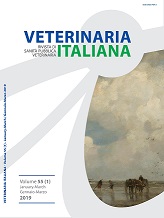Serological evidence suggests that several Simbu serogroup viruses circulated in Israel
DOI:
https://doi.org/10.12834/VetIt.1397.7622.2Abstract
Viruses of the Simbu serogroup are arboviruses that are known to cause outbreaks of abortion, stillbirth and congenitally deformed neonates. This study presents the results of antibody screening of Simbu serogroup viruses in heifers born in Israel after October 2013, and in adult milking cows born before May 2012. Thirteen dairy cattle farms in five regions, and one sheep flock, entered this study. Serum samples that were found to be positive by ELISA were further tested by specific virus- neutralization test against a panel of Simbu serogroup viruses including Akabane, Aino, Sathuperi, Shamonda, and Peaton viruses. Antibody detection in lactating adult cows revealed that several viruses were circulating in Israel between 2008-2014. Moreover, during autumn 2014 the heifers became serum-positive after being exposed to more than one Simbu serogroup virus concurrently. The results of this study shed new light on Simbu virus infections in Israel, and may contribute to the epidemiology of the Simbu serogroup around the Mediterranean Basin in general.



